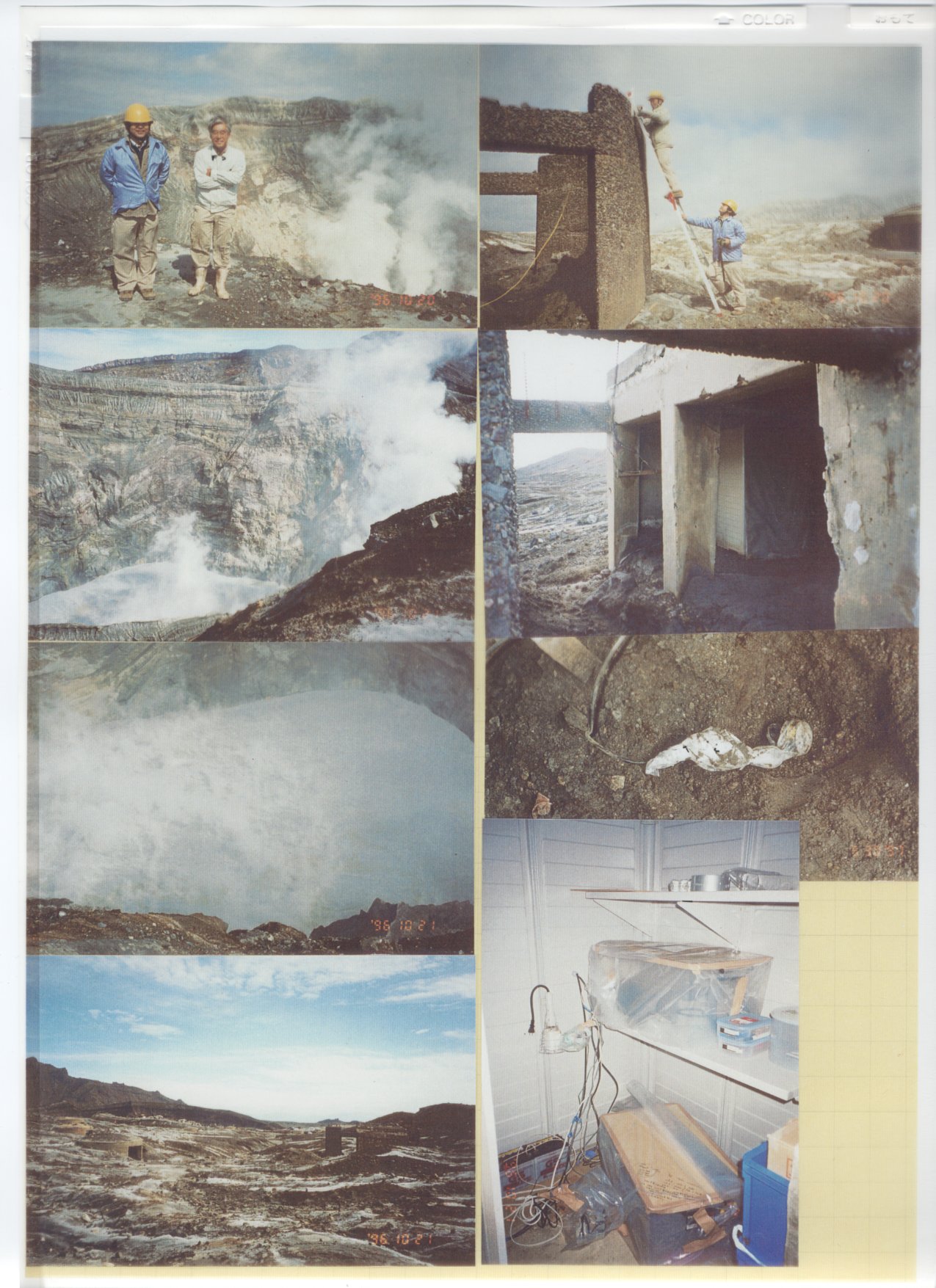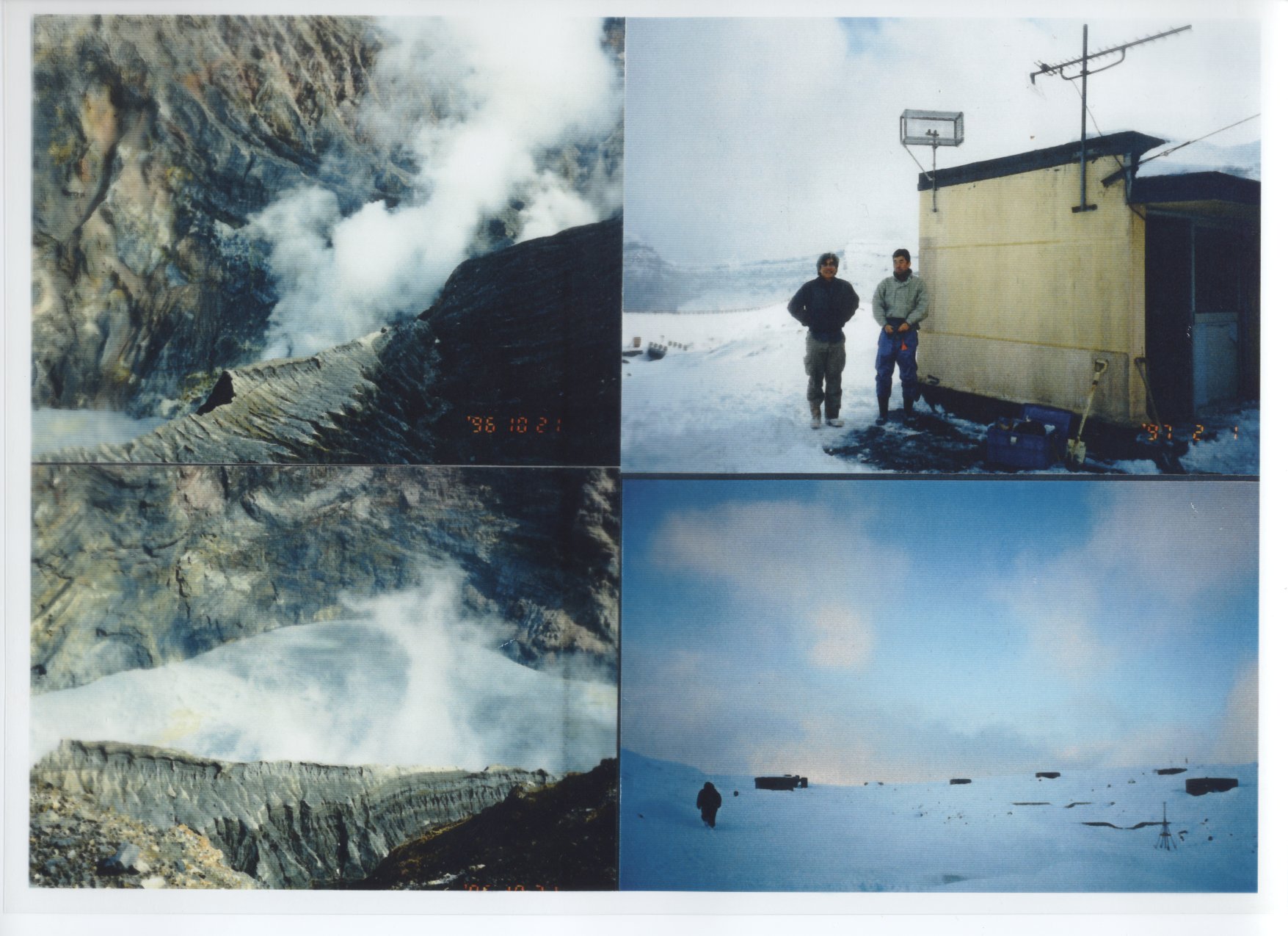その他の火山
阿蘇山(1990年代)の古い写真からスキャンした. 30.May.2011 08Aug 2023. English translation using DeepL.
Other volcanoes
Scanned from an old photo of Mt. Aso (1990s). 30.May.2011
前の職場の同僚(その後東北大教授となったTさん)の手伝いで何度か阿蘇山に通った.彼の作った爆風の圧力を計測する装置の実装のためだった.
現地でつきそっていただいたのは京大別府におられた火山観測の専門家T教授.(今はお2人とも定年退官されたが)
私にとっては生涯で唯一の火山における観測の経験であった.
I went to Mt. Aso several times to help a colleague from my former workplace (Dr. T, who later became a professor at Tohoku University). in the implementation of a device he had built to measure the pressure of the blast. He
was accompanied there by Professor T, an expert in volcano observation
at Beppu, Kyoto University (both of them are now retired).
It was the only experience for me to observe volcanoes in my lifetime.
阿蘇中央火口に立つ両T先生.右は圧力計の銅製のパイプを取り付ける私.古い避難小屋の擁壁にとりつけた.小屋の中には鉄製の格納庫を入れて,
ロープウエ
イの乗り場から引っ張ってきた電気で地震計と圧力計のデータをノートPCに記録するシステムを格納した.火山ガスがひどい場所なので,ノートPC
が錆びな
いようにビニールで厳重に包装したが半年後には金属部分にさびが浮いていた.地面の砂の中にビニール袋の中に入れて埋めた地震計も外装はさびつい
ていた.
しかし地震計の記録は数ヶ月分は記録できたはず.ただこの間は比較的穏やかな時期で一度も噴火がおこらずこの観測は成功しなかった.これらの避難
小屋はか
つて爆発時の緊急避難小屋として建設されたが,噴石より火山ガスによる被害が出始めたので,この区域は立ち入り禁止となり放置されてあったのを
我々が観測
に利用したもの.爆発の際はこの小屋のコンクリートの屋根を突き破る噴石も降ったとか.火山の恐ろしさを体験できる場所であった.くだんのT教授
は火山ガ
スの匂いがきつく心配する私に,匂いがするうちは大丈夫.匂いがしなくなると脳がやられているから気をつけろと言ってのけられた.
Installing the pipe on the ladder was me. I attached it to the retaining wall of an old evacuating hut. Inside
the hut, I put a steel hanger to house a system that records
seismograph and pressure gauge data to a laptop computer using
electricity power pulled from the ropeway station. Because
of the severe volcanic gases, the laptop was tightly wrapped in plastic
to prevent it from rusting, but six months later, rust was floating on
the metal parts. The exterior of the seismograph, which was buried in a plastic bag in the sand on the ground, was also rusted. However, the seismograph should have been able to record for several months. However, this was a relatively calm period during which no eruptions occurred and the observations were not successful. These
evacuation huts were constructed as emergency evacuation huts in the
event of an explosion, but when the volcanic gases began to cause more
damage than the cinders, the area was closed to visitors and left
unattended. When the explosion occurred, some cinders fell through the concrete roof of the hut. It was a place where we could experience the horror of volcanoes. Professor
T said to me because I was concerned about the strong smell of volcanic
gases, but he told me, "As long as you can smell it, you're fine. But if you do not smell the gas, your brain is dying!"

中央火口の湯だまりの様子(96年秋)と冬(97年2月)の阿蘇山頂(右).雪で熊本空港行きの飛行機が飛ばず,難儀した記憶が.ロープウエイ山
頂駅乗り
場の近くの小屋の屋上に鳥かごのような圧力計センサを取り付ける際の記念写真.これも結局噴火が起こらず,最後にはガスで根元の取り付け部が錆び
てしまい
いつか落ちてしまったとか聞いた.
Aso (right) in winter (February 1997) and a hot spring pool in the central crater (autumn 1996). I remember that the plane to Kumamoto Airport did not fly because of the snow and I had a hard time. Commemorative
photo of the installation of a pressure gauge sensor like a birdcage on
the roof of a hut near the ropeway summit station. I heard that this sensor did not erupt after all, and finally the base of the sensor rusted due to gas, and fell off one day.

Copyright
(c) 2011 Y.Okamoto, all rights reserved.

